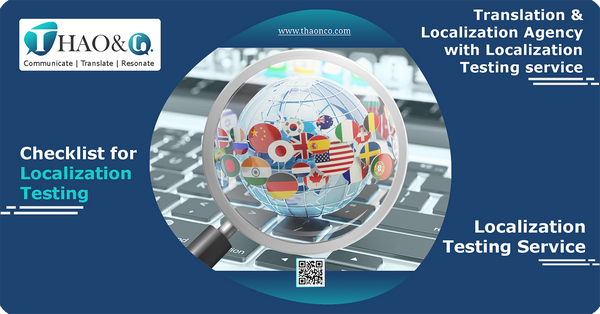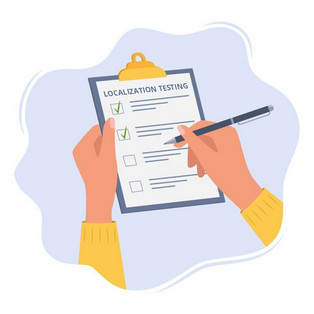Localization Testing is an important process to ensure that your software is appropriately and accurately localized. This is a crucial task when developing products for multiple international markets.
However, there’s more to localization than a simple language check for the translation. This process includes many other factors such as currency and measurement units, visual elements, symbols, audio, video, and more. To achieve optimal efficiency in localization testing, it is important that you follow a detailed and carefully prepared checklist.
In this article, Thao & Co. will provide you with comprehensive information on Localization Testing and an exhaustive checklist. By closely following our guide and using the checklist, you can rest assured that your software is professionally localized to the requirements of a local market.
Testing is a process that aims to check and evaluate the functionalities and efficiency of software. It focuses on verifying that the software meets the company’s requirements and quality standards before being officially launched.
Localization Testing is a special form of testing done to ensure that software localization is customized to become suitable for a specific region or market. Localization testing includes checking elements such as language, date format, currency units, symbols, and other cultural elements.
As a result, Localization Testing is an essential enabler to connect software companies with potential customers, thereby increasing more sale potentials. Localization Testing is a must-have for any business in the software development industry looking to expand its market, establish greater global presence, and create a seamless customer experience for end users.
Localization Testing helps ensure that the software can be used by local customers of the target markets without any issue. Localization Testing will help you:

After the software localization process, you need to head on these steps of localization testing as follows:
In this step, the testing team needs to establish the language requirements and conduct research on the overall culture of the target market. When this has been done, the team should verify the accuracy of the translated content, Adjustments should be made when necessary to ensure that the text is linguistically and culturally relevant to the local users.
It is important that a thorough evaluation is carried out on: the user interface, help features, user manual, error messages and function buttons. The testing team must ensures that all terminologies are correctly used, leaving no room for ambiguity. Should any bugs or errors are spotted, the testing team must make reports and give suggestions to fix the issues.
The localization testing team needs to make sure that the user interface is properly localized to specific contexts. To achieve this, an evaluation of the user interface including function buttons, help features, error messages, special characters, and symbols will be necessary.
Testing specialists are responsible that the user interface is aesthetically designed and contains no errors or bugs. In particular, when presented in another language, the software’s content may increase or decrease in length, thus, it is crucial that the font as well as overall visual appeal is preserved and remains consistent.
The software must function as expected without problems across locales. The localization testing team will have to pay attention to these checkpoints when reviewing the software functionalities: main and extra features, and features concerning the location and time.
After each individual feature has been inspected, the testing specialist will also have to ensure that they all work in tandem with each other and follow the users’ preferences or requirements. Afterwards, the software functions will be test run on all platforms, including different operating systems and devices to eliminate any remaining bug or error.
In the final check, the localization testing team needs to do a thorough test run of the localized software on various operating systems and devices.
Testing specialists have to ensure that the software is stable and operates smoothly as well as accurately in a variety of conditions. If any bug or error is found, the team will have to report it and propose potential solutions.

A localization testing checklist is a useful tool to help you make sure that all aspects of the software are properly localized. Below are some typical criteria in a localization testing checklist:
Effective use of the checklist above can help you ensure that important aspects of your software are properly localized. This is a crucial process that must be carried out in order to achieve preferable results at the target market.
1. Do not rush, take the necessary time you need to thoroughly inspect and ensure that everything runs as it should after your product has been localized.
2. It is recommended that you regularly retest your product to guarantee that it runs without issues on different operating systems and conditions.
3. Conduct test run on various operating systems, including mobile phones and PCs to evaluate the software compatibility and user experience.
4. Focus on language-specific issues, such as grammatical and lexical errors.
5. Ensure that all symbols, visual elements and formats are correctly displayed across different platforms.
6. Integrate localization testing into the overall testing process and make sure that all spotted errors have been resolved.

If these guidelines are closely followed, you can rest assured that your localization process have been executed effectively and properly. Should you have further questions on how to achieve optimal results in your localization project, don’t hesitate to contact Thao & Co. Translation Agency.
We will answer all of your questions and provide professional Software, Application, and Website localization service of the highest quality. Thao & Co. will help you professionally translate and localize your software, meeting your target market’s demands and preferences.
During the Localization Testing process, we can also support your developers in testing and evaluating the software after it has been translated into new languages, ensuring that the translations are accurate and native-like, and everything is aesthetically pleasing across locales. Therefore, you will be able to deliver the best user experience to your target customers, making you stand out amongst rival companies in the competitive market.
Visit our Get a Quote page to receive a free consultation and timely support today!